
5-Step Content Strategy for E-Commerce Websites
Creating and maintaining an e-commerce platform, and managing its content marketing strategy is not only …
15/04/2024 -
17 dk okuma
Stay up to date with Peakers
B2B Content Marketing Strategy is created providing you with the chance to demonstrate your knowledge and leadership with your target customers. The primary aim here is a completely different one: to get customers hooked to your brand and ensure that you are their first choice for doing business with.
Dealing with content marketing is not just about the selection of keywords and their regular posting. A brilliant B2B Content Marketing framework is based on audience profiling and communication with potential customers. In this article, we will elaborate more on the basic questions like “What is B2B content marketing strategy?” and explain in general 5 steps to develop your B2B Content Marketing Strategy and 10 tips to stay ahead of the game against your competitors. Keep reading!
A B2B content marketing strategy is a tool that can be used for the development of a business-to-business (B2B) marketing plan. This strategy, through numerous motivations, aims to bring products and services to other businesses, generating brand awareness, as well as transforming leads into repeat clients.
In B2B content marketing, it is critical to deliver useful and relevant content solving the biggest problems of the consumers. This is convertible to a blog, infographics, case studies, technical reviews, and educational videos.
Also, the strategic role of content marketing content creation and content sharing plays a critical role in B2B content marketing. To achieve the needed reach and impact your B2B content marketing strategy should dovetail with your social media content strategy to be efficient. E-mail, organic search, and advertising can also be employed in the B2B strategy by content marketing.
With a proper content market strategy businesses can benefit from many marketing issues. Let’s take a look at some of them:
Increases Brand Awareness: High-value content guarantees the rise of your business to the top of the pack as it reliably shapes your business into a positive brand in the industry. Here is how you can make them so reliable clients by interfacing them with regular, relevant, and interesting content.
Builds Trust: Content is a chance to demonstrate concrete proof of your business’s competence. Incorporating not only engagement but expressing your experience and knowledge shows prospective clients why they should go with you.
Increases Website Traffic: In the case of quality content original content not only catches your potential buyers’ attention but also turns their interest. There are many benefits that engagement content brings to businesses through the B2B marketing process. One of them is that the organic traffic comes to your website which raises awareness and strengthens your digital presence.
Longevity of Content: The content marketing efforts further build on the success of your business and their positive effects are felt long after the content has been published. This strategy of content marketing is thus a reasonable one for your business to ensure its growth. You can continue to receive value from a piece of content long after the day it was published, right up to the time it becomes irrelevant or outdated, that is- when dealing with timeless content.
Low Cost, High Revenue: Content marketing is cheap to set up and maintain. Although you might find the need to sell labor and a great deal of funds for the creation of content, the cost of these investments will be less compared to the profits that you’ll generate.
Effective at Every Stage of the Sales Funnel: Content stands as a multi-functional tool that performs an important role at every sales funnel phase. You can use content in the style of individual stages of the process to guide your customer in such a way that he is going to buy.
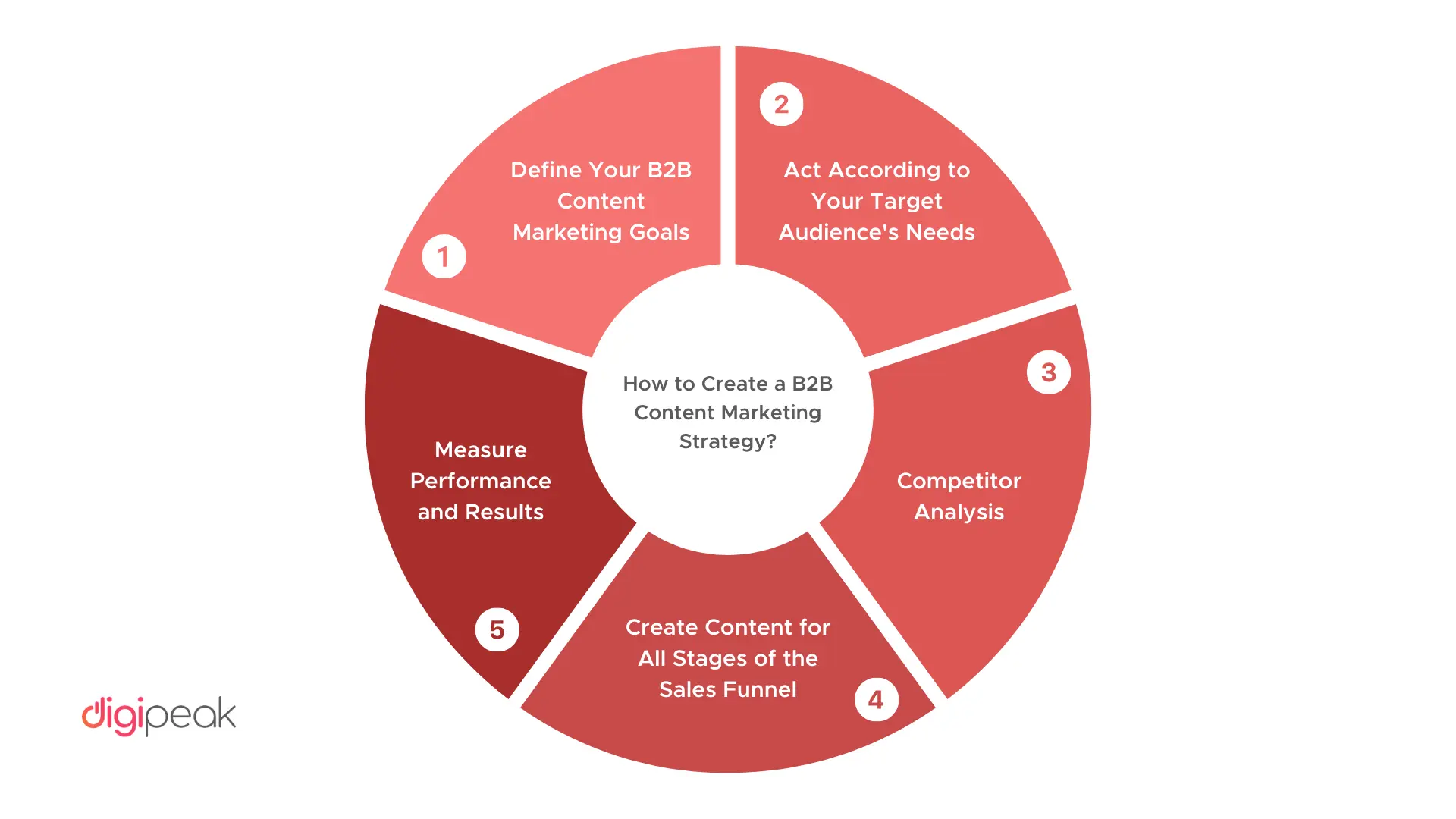
Let’s take a look at the five stages we’ve identified for a successful content marketing strategy:
The first step is to establish which of the content goals support the purposes of your business and focus your efforts on that. For instance, do you want to appeal to the public or those who are momentarily passing by? What are the criteria of actions; how will you measure the results yielded by the strategy?
Enunciate and pen down your goals for things to flow smoothly in this process of content marketing strategy building for you. The platform will also provide you with competent tips on the content quality and platform to use. By and large, the article will highlight agentry and this may include, for instance, audit reports and industry studies that will initiate leads.
Having identified content goals, you will find it easy to set the KPIs needed to know if the approach is bearing results or not.
The primary goal of content marketing is to make interesting and useful content for your target audience which helps you with good customer support. So, the most definite may be to get acquainted with how to interact with the target audience.
What is the level of necessity and difficulty of the majority of your customers? How can you orient the content in these thematic areas of your article at the same time? What is the most efficient route to address your consumer’s fundamental requirements and concerns? To these questions, the answers will set up the content marketing strategy that will effectively market your product or service.
It is very important to see and understand that you could be dealing with a variety of market segments depending on their specific demands.
The analysis of competitors’ strategies will shed light on what is effective and not. What key features are our competitors introducing and what does the market lack? Give it a shot and utilize the top-ranked content of your competitors. Then, compare it with yours. If you can outperform your competitors by approaching topics that drive good results differently than they do, for example by spending more time on the qualitative aspects, then this should be the content that you focus on. To locate things you want to change, you may as well examine the result of the underperforming content of your competitors in the same way.
Through the execution of competitor research methods like these, you can benefit from said tools. The other tools that are useful to me are Semrush, Screaming Frog, and Ahrefs.
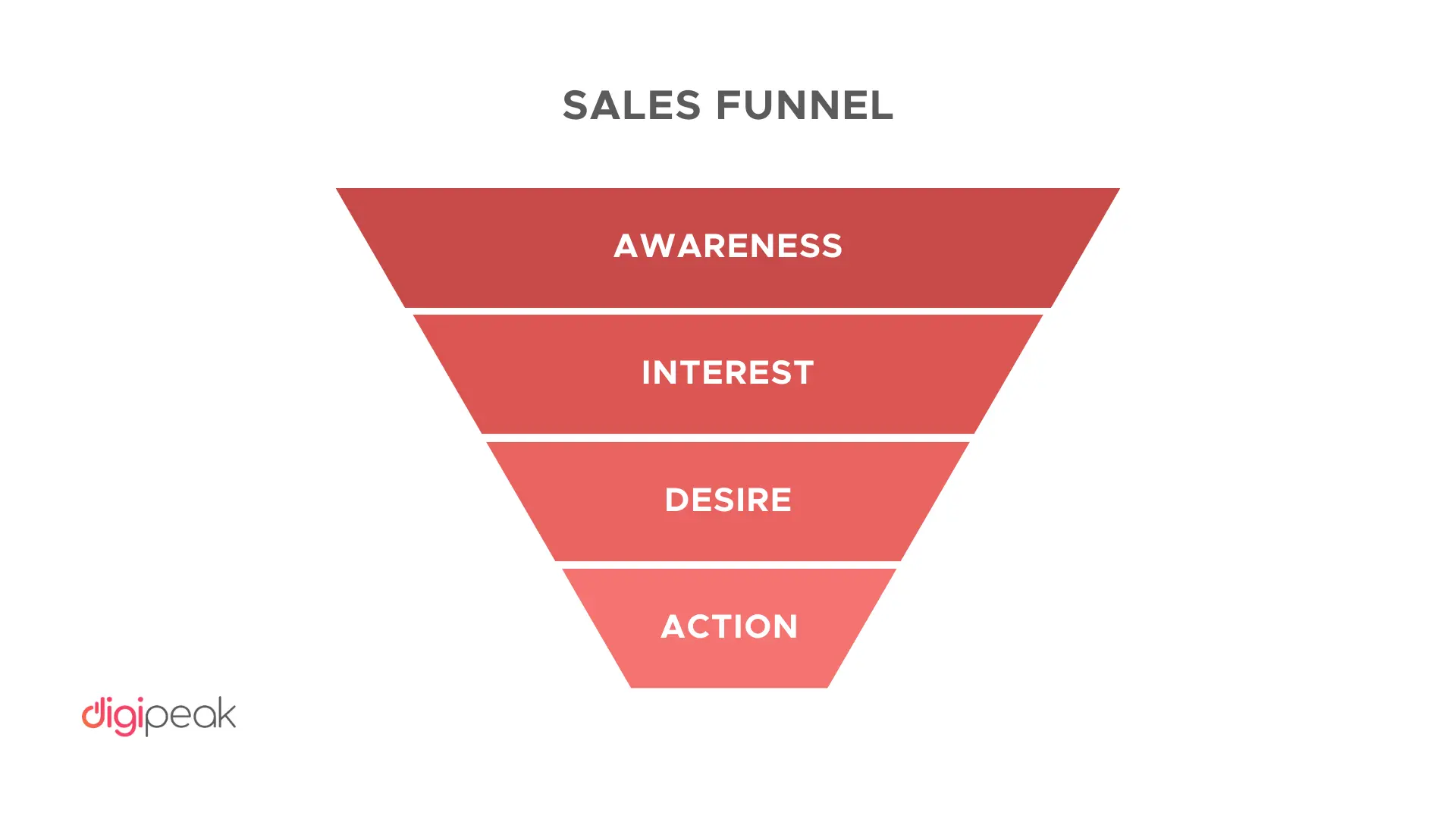
Visitors But No One Is Reading?
Get Your Free Content Audit Report!
Is your story strong enough ? Are your headlines engaging ? How persuasive is your content? We evaluate your content from every angle. Fill out the form now and get your free report!
Take Advantage of Automation with Artificial Intelligence!
How can you use your time more efficiently? Artificial intelligence saves you time by automating repetitive tasks. Learn how you can leverage AI to accelerate your business processes.
It is a long buying cycle for B2B, so you need content that can get buyers involved in the buying cycle stages with your brand. Every customer will be anticipating and expecting a specific set of needs relating to the phase of the sales funnel in which he/she is situated.
Top of the Funnel (Awareness) – It is where people begin knowledge about your brands and what you do with them. Such a sort of content comprises social media posts, blog posts, guest posts, infographics, and podcasts.
Middle of the Funnel Is (Interest Stage) – Right now, people start to compare your product or service to others. E-books, webinars, desktop feature pages, and video content are some of the regular marketing tools during the decision stage.
Bottom of the Funnel (Action/Sales) – it is now that the customers make up their minds and execute the buying process. Examples of functionality consist of case studies, presentations, proposal creation as well as the specification of prices.
Lastly, a review should be provided of the performance of the content marketing strategies in place. Trying various types of content and promotion styles until you find which ones work best could be the answer. First check which channels usually bring in money, and then focus all your efforts on them. Collecting performance metrics on your plan will serve as a guideline and help continuously improve your results. This will create a stable path to the success you deserve.
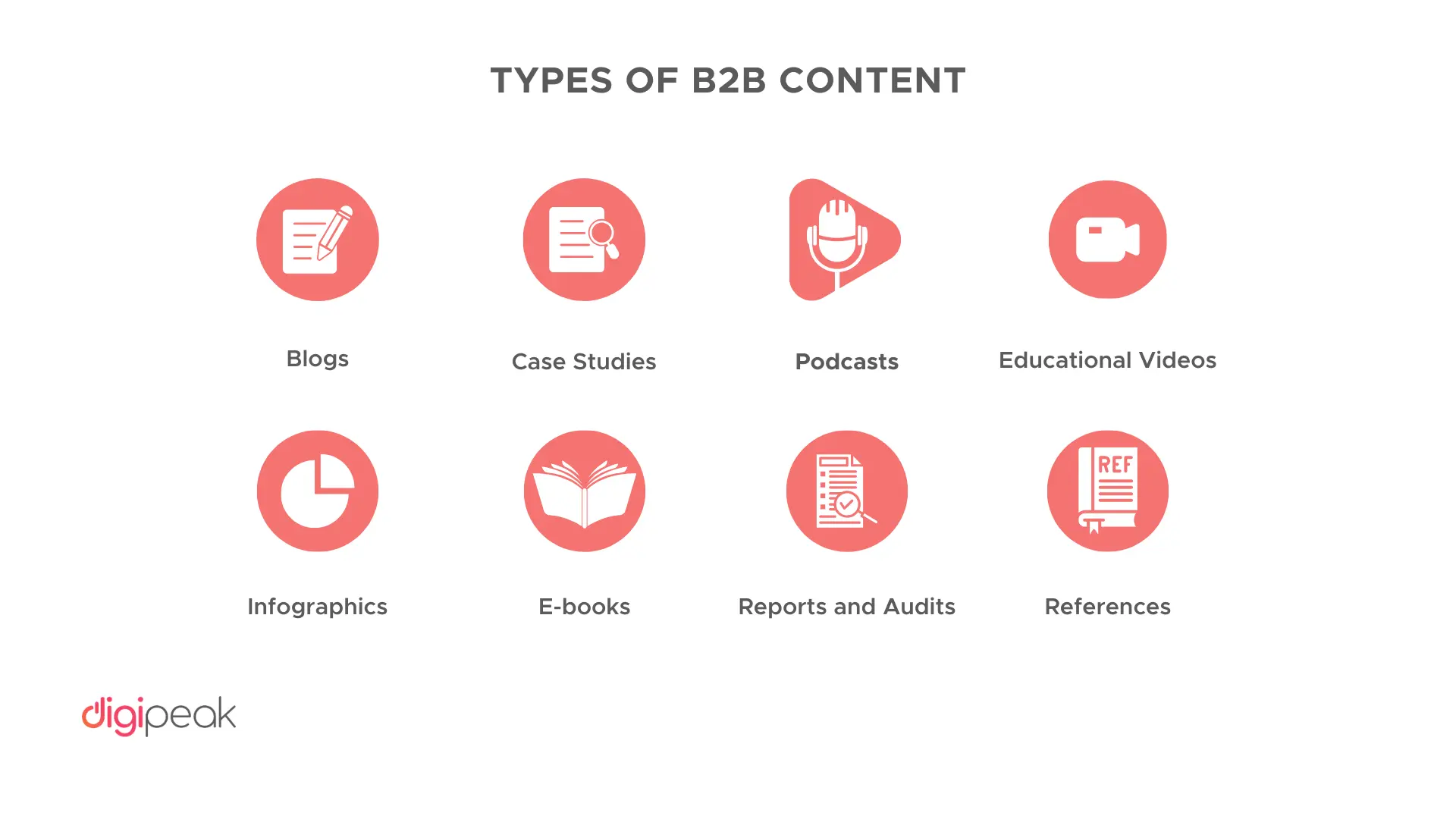
Various types of content can be utilized for B2B content marketing, such as:
Blogs: Blog articles are pieces of written content that will be published in the blog section of the website owned by your company. Blog posts can mostly be used as a tool for each stage of the sales funnel, but because there are many blog content ideas, they can be used in all stages. In the initial stage of awareness, the post should be informational in style and should not demand too many action yields from users (CTAs).
Nevertheless, blog topics that are getting more intricate or elaborate, calls-to-action messages can be added in line with the inbound marketing funnel. (For example, guide download, a try-on session, etc.,)
Case Studies: Examples taken in place during the actions stage of the sales funnel let your customers gain real information. Case studies are the most exact description process that gives a clear understanding of a solved problem. Now, business case studies could be borrowed from a specific company’s website. Featured businesses get their case studies of their performances from the different groups so that readers can relate to at least the studies presented to them.
Reports and Audits: Reports and audits are the Documents that can be downloaded to pass the information on what your business specializes in. As an example, sector research shows off the work industry and connects it to the field your business is in.
Audit and report often have the roles of spreading the business’s thoughts and knowledge. Before offering data to users, conducting investigations and investigations of research become inevitable. These programming components are in the assessment section of the sales funnel as they have important statistics.
E-Books: E-books depict the author’s knowledge by example on one particular subject. E-books find favor among users since they offer them instantaneous and vast information and working with it is often technologically easy. Nowadays, in the digital world which is developing very quickly, e-books and other similar pieces of content are a very important and efficient way for organizations to conduct their content marketing campaigns. The E-books that you construct and make available for your B2B content marketing will likewise contribute immensely to the recognition of your products as well as your identity as a brand.
Infographics: Infographics are designed to make complex information clearer by many different approaches to image layout. They are less likely a decision factor for the awareness stage customers of the sales funnel.
An infographic is a great way of making your business numbers accessible by reproducing them in a visual format that can be shared widely on social media, with your customers or publishers in the industry. The informative stage of the process requires that you make infographics that mainly provide general facts that the targeted society would like to know.
Podcasts: The podcasts consist of digital audio content divisible into many parts. In the case of podcasts, you can distribute them through platforms such as Spotify and Apple, or you can put them on your website anytime that you prefer. Such materials can be made by a single speaker or by organizing panel discussions and interviews of various experts in the field. Podcasts are a perfect fit for detailed information as it can be shared very dynamically.
Educational Videos: Considering that videos are comprehensive and appealing to the senses, they are the best way to tell people what you want them to know. A study conducted by Semrush showed that almost 50% of marketers think that videos are the best marketing content. You will have to begin by generating some videos that will be informative and provide useful industry insights and tips. They will surely attract your target audience’s attention. This will help customers who are at the awareness and evaluation stages.
References: Reference means a client review, which shows what your business is about. Such content can be in the mode of text or video. Social proofs, references, and testimonials would be the means of persuasion for your possible customers. In the usage, however, references may refer to the stages across the sales funnel.
Offering a personalized experience is one of the best ways to get effective results from your content marketing efforts. You can use simple automation tools to prepare pop-ups, chat options, and emails based on the actions people take on your website.
Good content has a purpose and inspiration. You must ensure that your content addresses the needs and expectations of your target audience. The content you create and share should provide solutions to the problems of your potential customers. These problems can be sector-specific or may include obstacles encountered at various stages of the sales funnel. When creating a B2B content marketing strategy, it is crucial to ensure that your content addresses a problem.
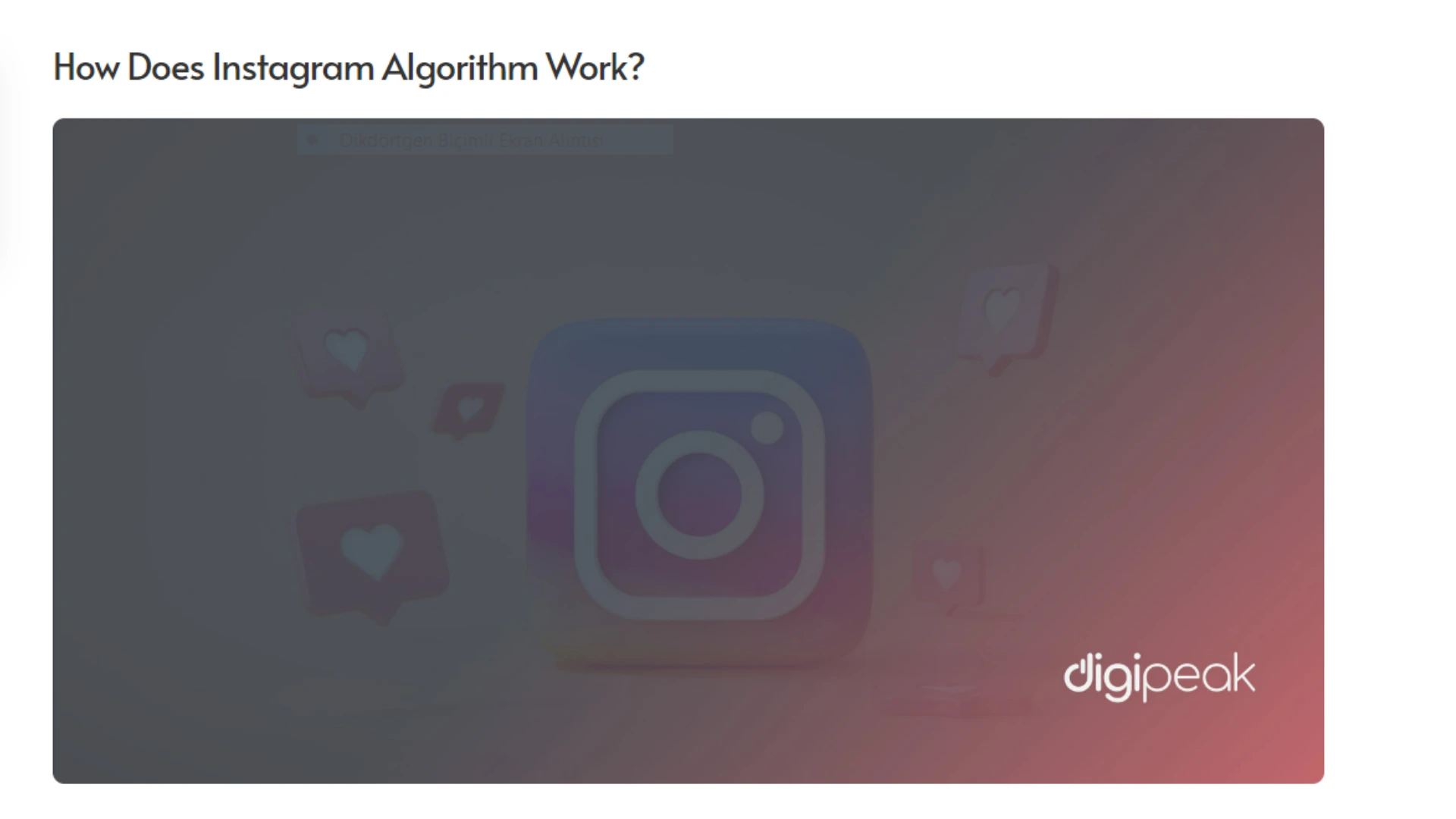
When developing your B2B content marketing strategy, it’s crucial to effectively utilize digital platforms to promote your products or services to other businesses and increase your sales.
Digital advertisements not only provide access to targeted audiences but also offer the opportunity to use the advertising budget more efficiently. To do this, you can pitch promotional articles from top executives to popular online news sources and industry blogs. You can even contribute to blogs of companies in your industry as long as they are not direct competitors!
Linking to proven, high-conversion blog posts is a unique opportunity to introduce your business to the right audience.
The number of backlinks to a webpage or post greatly influences whether it will rank highly. Encourage potential customers to link to your SEO-optimized blog posts and web pages to strengthen your content strategy. How do you do this? Offer profitable deals related to your products or services if they give you backlinks, or reciprocate with a backlink from a guest post you write on another website.
Another powerful but often underrated content marketing tip is content marketing partnerships.
You can collaborate with leading brands in your industry to create podcasts, webinars, e-books, events, and much more. This expands both your reach and influence. Partnerships provide the necessary conditions to prepare larger campaigns.
Moreover, you’re not limited to partnering only with companies! You can also create great content by working with individual consultants. The advantage of working with influential figures is that they can include your content in their social media posts and marketing newsletters.
The quickest way to increase organic traffic to your website and blog is to update existing content that already generates traffic. Updating articles takes only about 2 hours, costs nothing, and quickly produces great results.
From an SEO perspective, updating existing content is as important as creating new content.
To provide your readers with the best possible experience as an expert in your field, you must keep your content up to date. Updating content shows Google that it is still relevant today and will, therefore, rank higher in search results.
The best way to leverage existing content is by repurposing it. Repurposing content simply means converting existing content into different formats. This allows you to have high-quality content across multiple channels without exerting extra effort.
For example:
Many B2B content marketing strategies focus solely on creating content for search engines like Google and Bing, neglecting another crucial search engine: YouTube.
As mentioned earlier, video content yields the best results in terms of marketing efforts. YouTube is one of the most preferred platforms. Sharing a high-quality video focused on YouTube SEO just once a month can yield fantastic results. For detailed information on YouTube SEO, you can check out our blog post “What is YouTube SEO? How to Do YouTube SEO?”
Another effective tip is to create short/mini content on interesting and sometimes complex topics. These types of content will attract your target audience’s attention and turn them into loyal followers due to their problem-solving qualities. For instance, creating short social media content on trending topics is a simple way to significantly increase engagement.
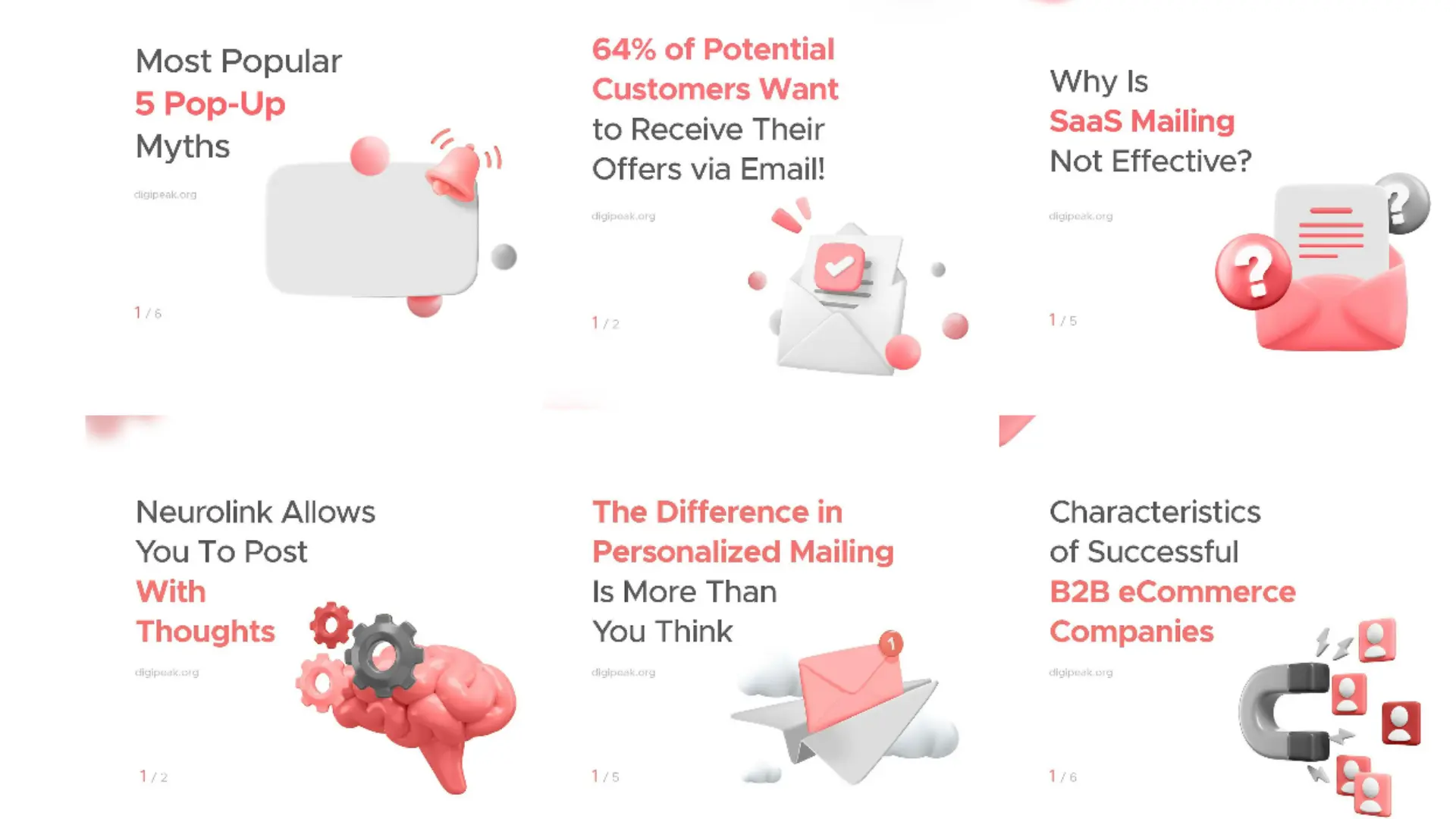
Creating pop-ups based on user behavior enhances user experience and increases your pop-up conversion rate as they are personalized solutions. For example, you can use a pop-up offering a free e-book after users have read a portion of your blog. This way, you can increase your conversion rates by using targeted, personalized strategies.
At Digipeak, we boost your success with strategies tailored to your business goals. Our main motivation is to add value to your brand with unique and original content that sets you apart from your competitors in the industry.
Digipeak’s content services cover a wide range, including blog posts, podcast content, e-books, infographics, and video content. With this variety, we deliver your business values to potential customers through the right channels, ensuring your target audience engages with your products and services.
Original and quality content is not only an excellent source of information but also one of the most effective marketing tools. Building connections with the target audience groups you want to reach is the first step in increasing your sales and strengthening your brand’s reputation. And you achieve this with strategically crafted content. If you want to leave your success to an experienced team rather than chance, schedule your free consultation now!
B2B content is a type of content used in business-to-business (B2B) relationships. This content is utilized to market products/services, establish connections, and increase brand awareness from one business to another.
Content strategy refers to the process of planning, creating, publishing, and managing content on printed or digital channels. Tailored content marketing strategies, varying according to the target audience, are specially designed for each business. At Digipeak, we produce unique and high-quality content to showcase your products and services effectively.
A B2B content marketing strategy consists of content that effectively reaches potential customers for businesses. In this context, a content plan is created step by step, and content tailored to the sales funnel is meticulously prepared. At Digipeak, we guarantee your success with content strategies crafted considering your brand’s goals and values.
The B2B market refers to the market where business-to-business communication and commercial transactions take place. This market is where products or services are marketed from one business to another.
Content marketing has four main goals. Firstly, it aims to create awareness by introducing your products/services to the target audience and increasing brand visibility. Secondly, it aims for conversion, turning potential customers into loyal ones. Thirdly, it aims to foster customer loyalty and retention. Lastly, it aims to establish authority and trust by sharing high-quality content, symbolizing expertise in the industry.
The stages of content marketing can be listed as follows: identifying the target audience, preparing a plan tailored to the audience’s needs, conducting competitor analysis, producing content suitable for every stage of the sales funnel, and analyzing measurable results.
In content marketing, brands can utilize various types of media and channels. The preference for each depends on the brand’s characteristics and goals. Media types that can be used include blogs, reports, case studies, podcasts, and infographics.
Evergreen content marketing involves creating content that does not lose value over time and continuously attracts traffic. This content, also known as evergreen content, generally consists of fundamental topics and detailed guides (“How-to” guides) that will always be searched for. With this content, your content marketing efforts will have a longer lifespan.
Get an Offer


Join Us So You Don't
Miss Out on Digital Marketing News!
Join the Digipeak Newsletter.
Related Posts

Creating and maintaining an e-commerce platform, and managing its content marketing strategy is not only …
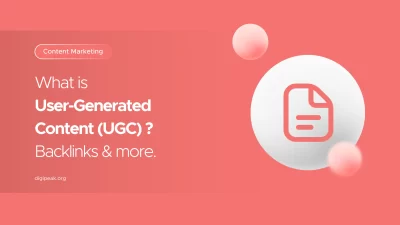
User-generated content (UGC) is any type of content (text, video, images, reviews, etc.) created by …
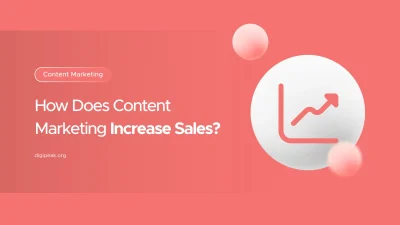
Content marketing is one of the most useful marketing tools in today's digital space that …

Welcome to our blog post full of exciting insights on content marketing strategies. Content marketing …